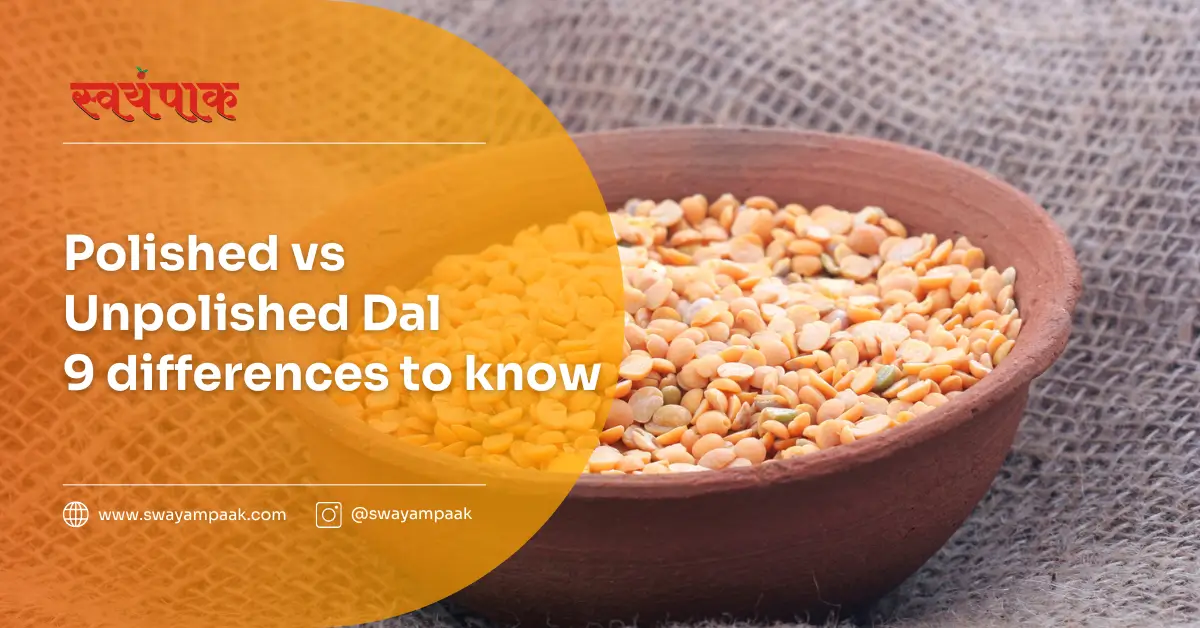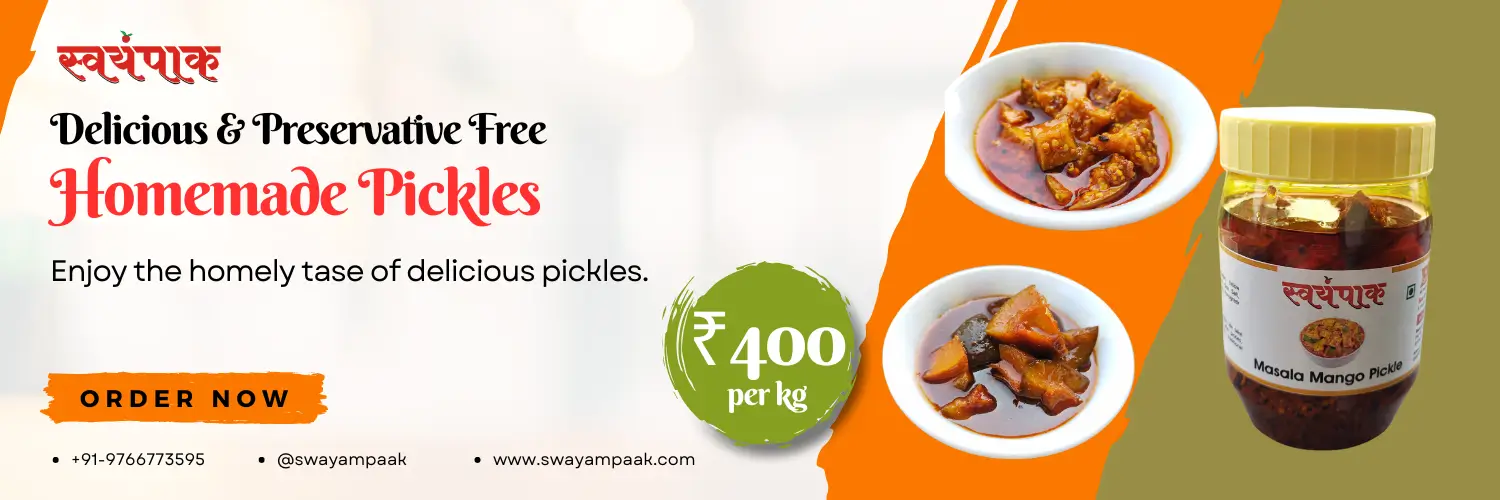Imagine coming home after a long day and savouring a warm bowl of dal, the ultimate comfort food in many Indian households. Whether it’s a simple yellow dal or a richly spiced tadka dal, this humble dish brings a sense of warmth and satisfaction.
However, when it comes to making dal, there’s an interesting choice to be made: polished or unpolished.
In This blog Polished vs Unpolished Dal, we will explore the differences between these two types of dal, helping you decide which one suits your culinary and nutritional needs.
7 key takeaways: Polished vs Unpolished Dal
Polished Dal:
- Offers a smooth and creamy texture.
- Cooks faster due to processing that removes the outer husk.
- Convenient choice for busy cooks and is readily available in stores.
- May lack some nutrients due to processing.
Unpolished Dal:
- Retains the outer husk for a more rustic texture.
- Higher in fibre content for better digestion and feeling full.
- Contains more vitamins and minerals due to minimal processing.
- Requires longer cooking time, soaking might be recommended.
Choosing Between Polished vs Unpolished Dal
- There’s no clear winner, it depends on your needs.
- Polished dal is ideal for those who prefer a smooth texture and convenience.
- Unpolished dal is a better choice for those seeking a nutritional boost with higher fibre and minerals.
- Consider experimenting with both types to find your favourite.
Polished Dal
Polished dal gets its sleek look and quick cooking time thanks to some processing magic. Imagine the dal grain like an onion.
Polished dal removes the outer “husk” similar to peeling the onion’s papery skin. Sometimes, this process goes a step further with polishing, achieving that smooth, shiny texture. This means faster cooking and a creamier mouthfeel, but some nutrients hiding in the husk get removed too.
Polished dal offers convenience and a delightful texture for busy cooks. The processing removes the outer layer, resulting in a super smooth and creamy dal when cooked. This translates to faster cooking times, perfect for those weeknight meals. Plus, its widespread availability in grocery stores makes it an easy choice for anyone looking to add a quick and comforting lentil dish to their repertoire. However, it’s important to remember that this processing comes with a trade-off, as some nutrients reside in the removed husk.
Polished dal shines in popular dishes that crave a smooth and creamy texture. Panchratan Dal, a luxurious blend of five lentils, often uses polished varieties to achieve a harmonious texture in the final dish.
The beloved Tadka Dal, known for its comforting warmth and spicy tempering, frequently features polished toor dal (pigeon pea) or moong dal (green gram) for a quick-cooking and irresistibly creamy base. These dishes showcase the versatility of polished dal, allowing you to whip up flavorful and satisfying meals without compromising on convenience.
Unpolished Dal
Unpolished dal skips the spa treatment! Unlike its polished cousin, unpolished dal keeps its natural, outer husk intact. This minimal processing results in a more rustic appearance, with a rougher texture compared to the smooth feel of polished dal.
While it might not win any beauty contests on the grocery store shelf, this unrefined approach packs a nutritional punch, as some valuable nutrients reside in the husk. The trade-off? It may take a bit longer to cook, but the wait might be worth the extra health benefits.
Nutritional Benefits: Polished vs Unpolished Dal
Unpolished dal goes beyond aesthetics, offering a nutritional edge. The key lies in its intact outer husk, which gets stripped away during the polishing process. This unrefined approach translates to a higher fibre content. This fibre keeps your digestive system happy and promotes feelings of fullness, aiding in weight management. But the benefits don’t stop there.
The husk also acts as a natural storehouse for essential minerals and vitamins. Since unpolished dal undergoes minimal processing, it retains more of these valuable nutrients compared to its polished counterpart.
This translates to a more well-rounded nutritional profile, making unpolished dal a potentially healthier choice for those seeking to boost their dietary intake. While the trade-off involves slightly longer cooking times, the extra wait might be a small price to pay for the potential health advantages unpolished dal offers.
Traditional Unpolished Dal Recipes
Unpolished dal takes centre stage in traditional dishes that celebrate its natural goodness. Khichdi, a comforting one-pot meal, features unpolished moong dal alongside rice. This simple dish is not just delicious but also revered for its gentle digestive properties, making it a popular choice for those seeking a light and healthy meal.
Moong dal also takes a starring role in Moong Dal Cheela, savoury pancakes made from ground unpolished moong dal. Packed with protein and easily customizable with spices and veggies, these Cheelas are a perfect high-protein breakfast or a satisfying snack option. These traditional dishes showcase the versatility of unpolished dal, allowing you to explore flavorful and healthy options that go beyond the convenience factor.
The Great Dal Debate: Polished vs Unpolished Dal
Texture Talk: Polished dal boasts a smooth and creamy mouthfeel, achieved through processing that removes the outer husk. This makes it perfect for those who prefer a more luxurious dal experience. Unpolished dal, on the other hand, retains its husk, resulting in a slightly rougher texture that some find more rustic and satisfying.
The Nutritional Showdown: Polished vs Unpolished Dal
| Aspect | Polished Dal | Unpolished Dal |
|---|---|---|
| Appearance | Smooth, shiny, and uniform | Natural, dull, and varied |
| Nutritional Value | Lower, due to removal of outer layer | Higher, retains more fiber and nutrients |
| Processing | Undergoes polishing process which removes husk | Minimal processing, retains husk |
| Cooking Time | Usually quicker to cook | May take longer to cook |
| Flavor | Milder, less earthy taste | Richer, more earthy taste |
| Shelf Life | Longer, as polishing reduces moisture content | Shorter, due to higher moisture content |
| Cost | Usually higher due to additional processing | Usually lower |
Unpolished dal packs a nutritional punch! The outer husk, absent in polished dal, is a treasure trove of dietary fibre. This fibre keeps you feeling fuller for longer and aids in digestion. Additionally, unpolished dal retains more vitamins and minerals due to minimal processing. So, if you’re looking to boost your fibre intake and nutrient profile, unpolished dal might be your champion.
Polished dal does have its advantages. Its smoother texture might be easier on sensitive digestive systems. Plus, the processing removes some complex sugars that can cause bloating for some people. And let’s not forget convenience! Polished dal generally cooks faster than unpolished dal, winning hearts in busy households.
The Verdict
There’s no clear winner. Ultimately, the best dal for you depends on your taste preference, dietary needs, and cooking style. Don’t be afraid to experiment with both polished and unpolished dal to discover your perfect match!
When it comes to cooking time, polished dal takes the lead. The removal of the outer husk during processing allows it to cook significantly faster than its unpolished counterpart. This makes polished dal a lifesaver for weeknight meals or when time is tight. However, unpolished dal requires a bit more patience.
The intact husk creates a barrier that extends cooking time. Pre-soaking unpolished dal helps soften the husk and reduces cooking time, but it still might take longer than polished dal. So, consider your schedule – if speed is a priority, polished dal might be your best bet. If you have more time and want to maximize the nutritional benefits, unpolished dal is worth the wait.
Balanced Perspective
Let’s take a step back from the dal debate and embrace a balanced perspective. Both polished and unpolished dals deserve a place on your dinner table! Polished dal offers a smooth texture, cooks quickly, and is readily available, making it a convenient choice for busy schedules. Unpolished dal, on the other hand, brings a heartier texture and a nutritional boost thanks to its higher fibre content and retained minerals.
Here’s the key: variety is key! Incorporating both types of dal into your diet allows you to enjoy the best of both worlds. Experiment with polished dal for quick and creamy dishes, and explore unpolished dal for meals packed with fibre and nutrients. Ultimately, the “best” dal depends on the occasion and your needs. So, embrace the variety and explore the delicious world of dals!
Conclusion
In the world of dal, there’s no single hero. Polished dal shines with its smooth texture and speedy cooking, making it a star in countless traditional dishes. Need a quick weeknight meal? Polished dal is your champion. However, unpolished dal emerges as a nutritional powerhouse.
Its intact husk retains valuable fibre for gut health and a feeling of fullness, while also boasting a higher mineral content. Looking for a health boost? Unpolished Dal might be your perfect teammate.
Ultimately, the “best” deal depends on your priorities. Do you crave a creamy texture and convenience? Polished dal has your back. Are you prioritizing fibre and nutrient content? Unpolished dal is your ally. The good news? You don’t have to choose! Explore both types of dal and discover your favourites.
Whip up creamy Panchratan Dal with polished lentils, and enjoy the comforting warmth of Tadka Dal made with unpolished moong dal. Embrace the variety and explore the delicious possibilities that both polished and unpolished dal offer!


